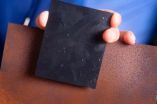(Press-News.org) The first purely silicon oxide-based 'Resistive RAM' memory chip that can operate in ambient conditions – opening up the possibility of new super-fast memory - has been developed by researchers at UCL.
Resistive RAM (or 'ReRAM') memory chips are based on materials, most often oxides of metals, whose electrical resistance changes when a voltage is applied – and they "remember" this change even when the power is turned off.
ReRAM chips promise significantly greater memory storage than current technology, such as the Flash memory used on USB sticks, and require much less energy and space.
The UCL team have developed a novel structure composed of silicon oxide, described in a recent paper in the Journal of Applied Physics, which performs the switch in resistance much more efficiently than has been previously achieved. In their material, the arrangement of the silicon atoms changes to form filaments of silicon within the solid silicon oxide, which are less resistive. The presence or absence of these filaments represents a 'switch' from one state to another.
Unlike other silicon oxide chips currently in development, the UCL chip does not require a vacuum to work, and is therefore potentially cheaper and more durable. The design also raises the possibility of transparent memory chips for use in touch screens and mobile devices.
The team have been backed by UCLB, UCL's technology transfer company, and have recently filed a patent on their device. Discussions are ongoing with a number of leading semiconductor companies.
Dr Tony Kenyon, UCL Electronic and Electrical Engineering, said: "Our ReRAM memory chips need just a thousandth of the energy and are around a hundred times faster than standard Flash memory chips. The fact that the device can operate in ambient conditions and has a continuously variable resistance opens up a huge range of potential applications.
"We are also working on making a quartz device with a view to developing transparent electronics."
For added flexibility, the UCL devices can also be designed to have a continuously variable resistance that depends on the last voltage that was applied. This is an important property that allows the device to mimic how neurons in the brain function. Devices that operate in this way are sometimes known as 'memristors'.
This technology is currently of enormous interest, with the first practical memristor, based on titanium dioxide, demonstrated in just 2008. The development of a silicon oxide memristor is a huge step forward because of the potential for its incorporation into silicon chips.
The team's new ReRAM technology was discovered by accident whilst engineers at UCL were working on using the silicon oxide material to produce silicon-based LEDs. During the course of the project, researchers noticed that their devices appeared to be unstable.
UCL PhD student, Adnan Mehonic, was asked to look specifically at the material's electrical properties. He discovered that the material wasn't unstable at all, but flipped between various conducting and non-conducting states very predictably.
Adnan Mehonic, also from the UCL Department of Electronic and Electrical Engineering, said: "My work revealed that a material we had been looking at for some time could in fact be made into a memristor.
"The potential for this material is huge. During proof of concept development we have shown we can programme the chips using the cycle between two or more states of conductivity. We're very excited that our devices may be an important step towards new silicon memory chips"
The technology has promising applications beyond memory storage. The team are also exploring using the resistance properties of their material not just for use in memory but also as a computer processor.
INFORMATION:
The work was funded by the Engineering and Physical Sciences Research Council.
Notes for Editors
1. For more information or to interview Dr Tony Kenyon, please contact Clare Ryan in the UCL Media Relations Office on tel: +44 (0)20 3108 3846, mobile: +44 07747 565 056, out of hours +44 (0)7917 271 364, e-mail: clare.ryan@ucl.ac.uk.
2. 'Resistive switching in silicon suboxide films" is published online in the Journal of Applied Physics. The paper is available for download here: http://jap.aip.org/resource/1/japiau/v111/i7/p074507_s1
3. Journalists can also obtain copies of the paper by contacting UCL Media Relations.
4. Images of the silicon chip described here are available to journalists on request from UCL Media Relations.
About UCL (University College London)
Founded in 1826, UCL was the first English university established after Oxford and Cambridge, the first to admit students regardless of race, class, religion or gender, and the first to provide systematic teaching of law, architecture and medicine. We are among the world's top universities, as reflected by performance in a range of international rankings and tables. UCL currently has 24,000 students from almost 140 countries, and more than 9,500 employees. Our annual income is over £800 million.
www.ucl.ac.uk | Follow us on Twitter @uclnews
About UCLB
UCLB is a leading technology transfer company that supports and commercialises research and innovations arising from UCL, one of the UK's top research-led universities. UCLB has a successful track record and a strong reputation for identifying and protecting promising new technologies and innovations from UCL academics. It invests directly in development projects to maximise the potential of the research and manages the commercialisation process of technologies from the laboratory to market. UCLB supports UCL's Grand Challenges of increasing UCL's positive impact on and contribution to Global Health, Sustainable Cities, Intercultural Interaction and Human Wellbeing.
For further information, please visit www.uclb.com
END
WASHINGTON — Whether you're an iPerson who can't live without a Mac, a Facebook addict, or a gamer, you know that social media and technology say things about your personality and thought processes. And psychological scientists know it too – they've started researching how new media and devices both reveal and change our mental states.
Two recent articles in the journal Perspectives on Psychological Science, a publication of the Association for Psychological Science, explored how trends in technology are changing the questions psychological scientists are asking and the ...
BUFFALO, N.Y. -- University at Buffalo researchers are making significant progress on rust-proofing steel using a graphene-based composite that could serve as a nontoxic alternative to coatings that contain hexavalent chromium, a probable carcinogen.
In the scientists' first experiments, pieces of steel coated with the high-tech varnish remained rust-free for only a few days when immersed continuously in saltwater, an environment that accelerates corrosion.
By adjusting the concentration and dispersion of graphene within the composite, the researchers increased to about ...
The Hadley Nursing Center at the Specialty Hospital Of Washington (SHW), joined forces with 4th and 5th grade students at Martin Luther King Jr. Elementary School in the Healing Walls Student Art Exhibit.
The Healing Walls project was developed by Cheron McNear, Marketing Coordinator for Specialty Hospital of Washington, and is designed to provide the patients and residents in our facility with uplifting artwork that will inspire and assist them in their healing process. The students were led by their art teacher, Mr. Bryan, who directed the theme of the artwork around ...
Andre' Haynes 'The People's Publicist' announced today that Richard Knapp of Las Vegas, NV has won the Award of Excellence of the Screenplay Competition at the 2012 CIFF, for his screenplay, "Can Richard Come Out and Play?". Richard Knapp's Award of Excellence was presented on March 31, 2012 at the Closing Night Award Ceremony at Edgewater Casino's Stadium Club Theatre.
CIFF is gaining a reputation for its wide variety of film genres, and has quickly garnered a respected following for its dynamic selections. Held each year in Vancouver, BC, the festival brings ...
In our everyday life, we use gasoline, diesel, plastics, rubbers, and numerous chemicals that are derived from fossil oil through petrochemical refinery processes. However, this is not sustainable due to the limited nature of fossil resources. Furthermore, our world is facing problems associated with climate change and other environmental problems due to the increasing use of fossil resources. One solution to address above problems is the use of renewable non-food biomass for the production of chemicals, fuels and materials through biorefineries. Microorganisms are used ...
Athens, Ga. – Decades of research show people born into poverty are likely to continue to live that way as adults. But one University of Georgia researcher has found a way out—education.
Children reared in disadvantaged communities and poor families earn less money and experience more health problems as adults than do children raised without adversity, according to Kandauda Wickrama, a professor of human development and life science in the UGA College of Family and Consumer Sciences.
"Early adverse life experiences, such as community or family poverty, have a detrimental ...
Montreal, May 18, 2012 – The surgical team at the Montreal Heart Institute (MHI) achieved a North American surgical milestone on May 1st with a sutureless aortic valve replacement through a thoracic incision just five centimetres long. The two patients in their seventies who underwent this innovative procedure, which was performed by cardiac surgeons Denis Bouchard and Michel Carrier, were doing well only one week after their operations.
A novel combination
"This innovative combination of implanting a Perceval™ S valve through a minimally invasive thoracotomy signals ...
It was used to help Apollo astronauts navigate in space, and has since been applied to problems as diverse as economics and weather forecasting, but Harvard scientists are now using a powerful statistical tool to not only track sea level rise over time, but to determine where the water causing the rise is coming from.
As described in an April 23 paper in the Proceedings of the National Academy of Sciences (PNAS), graduate students Eric Morrow and Carling Hay demonstrate the use of a statistical tool called a Kalman smoother to identify "sea level fingerprints" – tell-tale ...
Vacuum tubes have been retro for decades. They almost completely disappeared from the electronics scene when consumers exchanged their old cathode ray tube monitors for flat screen TVs. Their replacement – the semiconductor – is generally the cheaper, lighter, more efficient, and easier to manufacture of the two technologies. But vacuum tubes are more robust in high-radiation environments such as outer space. And since electrons travel faster in a vacuum than through a semiconductor, vacuum tubes are an intrinsically better medium for electricity.
An international team ...
Quantum physics promises faster and more powerful computers, but quantum versions of basic logic functions are still needed to bring this technology to fruition. Researchers from the University of Cambridge and Toshiba Research Europe Ltd. have taken one step toward this goal by creating an all-semiconductor quantum logic gate, a controlled-NOT (CNOT) gate. They achieved this breakthrough by coaxing nanodots to emit single photons of light on demand.
"The ability to produce a photon in a very precise state is of central importance," said Matthew Pooley of Cambridge ...

